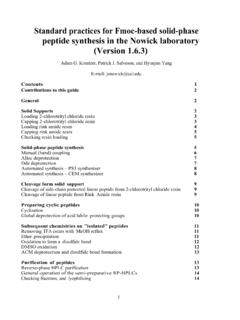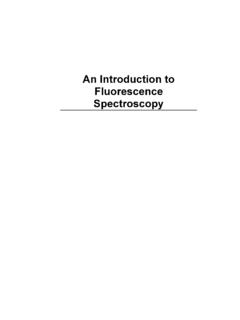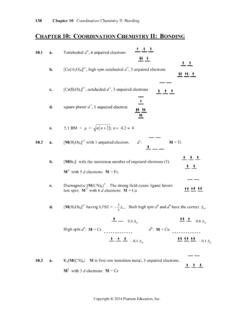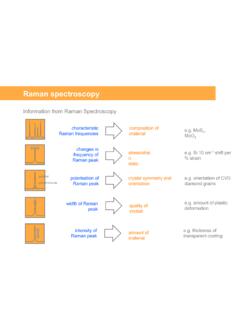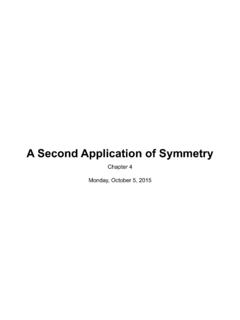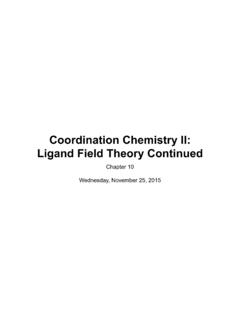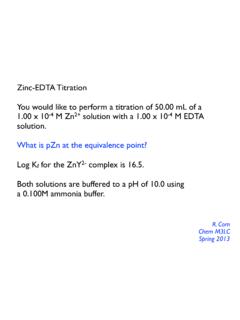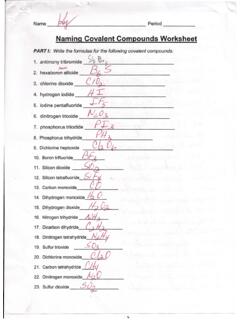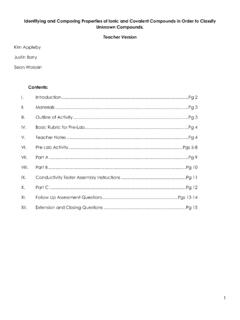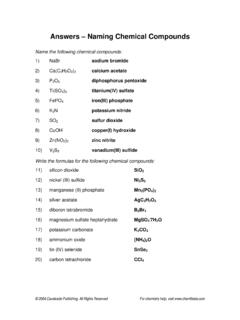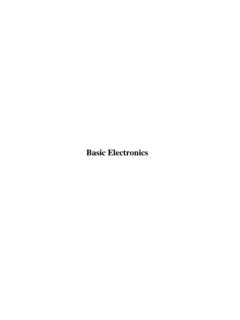Transcription of Lecture B1 Lewis Dot Structures and Covalent Bonding
1 Lecture B1 Lewis Dot Structures andCovalent Lewis & Linus PaulingTwo American ChemistsLinus Pauling1901-1994G. N. Lewis1875-19461. First proposed by Lewis in his seminal 1916 J. Am. Chem. Soc. publication (before QM was discovered!).2. Lewis proposed that Covalent bonds consist of shared pairs of electrons. He created a powerful empirical formalism ( Lewis dot Structures ) for understanding Bonding in simple Linus Pauling created a picture of Covalent Bonding that employed Quantum Mechanics (and won the 1954 Nobel Prize for it).The Covalent Lewis , circa 1902 - the cubical Lewis , Journal of the American Chemical Society 38 (1916) Lewis , Journal of the American Chemical Society 38 (1916) still think about Covalent bonds the way Lewis did. In contrast to ionic bond, electrons are shared, not ..if the atoms are identical, then electrons are equally shared - an example of a perfectly nonpolar Covalent Covalent bond formation, atoms go as far as possible toward completing their octets by sharing electron bonds are drawn as pairs are drawn as pairs of II2 moleculeLewis dot Structures provide a simple, but extremely powerful,formalism for representing Covalent Bonding in single bond , consisting of a pair of dot Structures provide a simple, but extremely powerful,formalism for representing Covalent Bonding in nonbonding pair of electrons: a lone pair Lewis dot Structures provide a simple, but extremely powerful,formalism for representing Covalent Bonding in : no geometric information!
2 Lecture B1 Systematic Method for CreatingLewis Dot StructuresLewis Dot Structures can be produced by following a sequence of steps. Let s produce a Lewis Dot Structure for:NH4+ (the ammonium ion).Step 1: Count valence electrons:N = 54 x H = 4 x 1 = 4 + = -1 Total = 5+4-1= 8 electrons = 4 bonds and lone Dot Structures can be produced by following a sequence of steps. Let s produce a Lewis Dot Structure for:NH4+ (the ammonium ion).Step 1: Count valence electrons:N = 54 x H = 4 x 1 = 4 + = -1 Total = 5+4-1= 8 electrons = 4 bonds and lone 2: Arrange the atoms (identify a central atom, if possible).NHHHH+ Lewis Dot Structures can be produced by following a sequence of steps. Let s produce a Lewis Dot Structure for:NH4+ (the ammonium ion).Step 1: Count valence electrons:N = 54 x H = 4 x 1 = 4 + = -1 Total = 5+4-1= 8 electrons = 4 bonds and lone 2: Arrange the atoms (identify a central atom, if possible).
3 Step 3: Place electron pairs on the atoms as either bonds or lone + Lewis Dot Structures can be produced by following a sequence of steps. Let s produce a Lewis Dot Structure for:NH4+ (the ammonium ion).Step 1: Count valence electrons:N = 54 x H = 4 x 1 = 4 + = -1 Total = 5+4-1= 8 electrons = 4 bonds and lone 2: Arrange the atoms (identify a central atom, if possible).Step 3: Place electron pairs on the atoms as either bonds or lone + Lewis Dot Structures can be produced by following a sequence of steps. Let s produce a Lewis Dot Structure for:NH4+ (the ammonium ion).Step 1: Count valence electrons:N = 54 x H = 4 x 1 = 4 + = -1 Total = 5+4-1= 8 electrons = 4 bonds and lone 2: Arrange the atoms (identify a central atom, if possible).Step 3: Place electron pairs on the atoms as either bonds or lone 4: Count electrons and compare with known count. If octet rule is satisfied for all atoms and the electron count is right, you re +8 valence electronsaround N!
4 Lecture B1 Lewis Dot StructuresMultiple Lewis , Journal of the American Chemical Society 38 (1916) example: Let s produce a Lewis Dot structure for: acetone: (CH3)2CO. Step 1: Count the valence electrons: 3 x C = 12 6 x H = 6 x 1 = 6 O = 6 Total = 12+6+6= 24 electrons = 12 bondsor lone example: Let s produce a Lewis Dot structure for: acetone: (CH3)2CO. Step 2: Arrange the atoms: Identify a central atom. If you have C or O to choose from, go with example: Let s produce a Lewis Dot structure for: acetone: (CH3)2CO. Step 3: Place 12 electron pairs on the example: Let s produce a Lewis Dot structure for: acetone: (CH3)2CO. Step 3: Place 12 electron pairs on the Bonds, Three Lone Pairs ..another example: Let s produce a Lewis Dot structure for: acetone: (CH3)2CO. Step 4: Check for the octet Bonds, Three Lone Pairs oops -- only 6 e!..another example: Let s produce a Lewis Dot structure for: acetone: (CH3)2CO.
5 Step 4: Check for the octet Bonds (one double bond), Two Lone Pairs Better!Done!..another example: Let s produce a Lewis Dot structure for: acetone: (CH3)2CO. Step 4: Check for the octet takes practice, but then becomes the polyatomic arrangement can be about Double 07 (Nitrogen)?Step 1: 10 valence electrons/five bonds and lone pairsHow about Double 07 (Nitrogen)?Step 1: 10 valence electrons/five bonds and lone pairsStep 2: Arrange about Double 07 (Nitrogen)?Step 1: 10 valence electrons/five bonds and lone pairsStep 2: Arrange 3: Fill in electron pairs and about Double 07 (Nitrogen)?Step 1: 10 valence electrons/five bonds and lone pairsStep 2: Arrange 3: Fill in electron pairs and about Double 07 (Nitrogen)?Step 1: 10 valence electrons/five bonds and lone pairsStep 2: Arrange 3: Fill in electron pairs and 4: Octet rule obeyed!A Triple Bond!
6 NNmultiple bonds have higher bond dissociation quantitative comparison of CC bondsN2 Bond Dissociation Energy: 941 kJ mol-1bond lengths are inversely correlated withbond energies - shorter bonds are 07 is very strong! Lecture B1 Lewis Dot StructuresFormal ChargeLet s produce a Lewis Dot structure for carbon disulfide, CS2. Step 1: Count valence electrons: C = 4 2 x S = 6 x 2 = 12 Total = 4 + 12 = 16 e/8 electron s produce a Lewis Dot structure for carbon disulfide, CS2. Step 1: Count valence electrons: C = 4 2 x S = 6 x 2 = 12 Total = 4 + 12 = 16 e/8 electron pairs. Step 2: Arrange the atoms. Go with Carbon in the s produce a Lewis Dot structure for carbon disulfide, CS2. Step 1: Count valence electrons: C = 4 2 x S = 6 x 2 = 12 Total = 4 + 12 = 16 e/8 electron pairs. Step 2: Arrange the atoms. Go with Carbon in the center. Step 3: Fill in the electron s produce a Lewis Dot structure for carbon disulfide, CS2.
7 Step 1: Count valence electrons: C = 4 2 x S = 6 x 2 = 12 Total = 4 + 12 = 16 e/8 electron pairs. Step 2: Arrange the atoms. Go with Carbon in the center. Step 3: Fill in the electron s produce a Lewis Dot structure for carbon disulfide, CS2. Step 1: Count valence electrons: C = 4 2 x S = 6 x 2 = 12 Total = 4 + 12 = 16 e/8 electron pairs. Step 2: Arrange the atoms. Go with Carbon in the center. Step 3: Fill in the electron pairs. Step 4: Check for the octet s produce a Lewis Dot structure for carbon disulfide, CS2. Step 1: Count valence electrons: C = 4 2 x S = 6 x 2 = 12 Total = 4 + 12 = 16 e/8 electron pairs. Step 2: Arrange the atoms. Go with Carbon in the center. Step 3: Fill in the electron pairs. Step 4: Check for the octet !Let s produce a Lewis Dot structure for carbon disulfide, CS2. Step 1: Count valence electrons: C = 4 2 x S = 6 x 2 = 12 Total = 4 + 12 = 16 e/8 electron pairs.
8 Step 2: Arrange the atoms. Go with Carbon in the center. Step 3: Fill in the electron pairs. Step 4: Check for the octet wait, what about??SSCTo decide between these two candidate Structures , we needto calculate the formal charges on the wins!Less formal charge is better. Thus, SCS wins!Carbon dioxide, CO2, i s isoelectronic with carbon disulfide, CS2. Nitrous oxide, N2O, is also isoelectronic with carbon disulfide, CS2. Lecture B1 Lewis Dot StructuresResonanceWhen multiple Lewis Dot Structures exist that are differentiated only by the positions of the electrons (the positions of the atoms are identical), the ACTUAL structure is a weighted average of these resonance predict that the three N-O bonds in the nitrate ion are identical in predict that the two C-O bonds in the acetate ion are identical in Example:And Another Example: BenzeneWe predict that all of the C-C bonds in benzene have the same resonance Structures for normally, Chemists represent benzene like this: Lecture B1 Lewis Dot StructuresExceptions to the Octet Rulean example:Grades are often computed using a weighted average.
9 Suppose that homework counts 10%, quizzes 20%, and tests 70%.If Pat has a homework grade of 92, a quiz grade of 68, and a test grade of 81, thenPat's overall grade = ( )(92) + ( )(68) + ( )(81) = the benzene, the actual structure is the average ofthe possible resonance Structures , but this is often not the case when resonance Structures with a range of formal charge values are possible. In this case, the actual structure willbe a weighted average of the available resonance Structures . A what? How do we weight resonance Structures ?An example: Which is the better Lewis Dot representation for the phosphate ion, PO43-?We have to look at the formal charge arguments structure shown at right has fewer formal charges, has 10 electrons - is this ok?An example: Which is the better Lewis Dot representation for the phosphate ion, PO43-?
10 If 10 electrons is okay for P, then less charge is example: Which is the better Lewis Dot representation for the phosphate ion, PO43-?An example: Which is the better Lewis Dot representation for the phosphate ion, PO43-?If 10 electrons is okay for P, then less charge is can use its d electrons to expand its valence than 8 electrons = "hypervalent"What if a second double bond is added?- formal charge on that O goes from -1 to 0- formal charge on P goes from 0 to -1 - total number of formal charges is electron count on P goes from 10 to 12. If 12 electrons is okay for P, then is it better to charge P or O?Actually, all of these resonance Structures contribute to the weighted average resonance hybrid that is weighting factorlower weighting factorlower weighting factorWe need more information to determine the exact weighting will introduce the concept of electronegativity to help with example: Rank these Lewis dot resonance Structures for cyanate (NCO-) from best to worst:Final example: Rank these Lewis dot resonance Structures for cyanate (NCO-) from best to worst:Again, Pauling's concept of electronegativity will help with exception to the octet rule:1.
